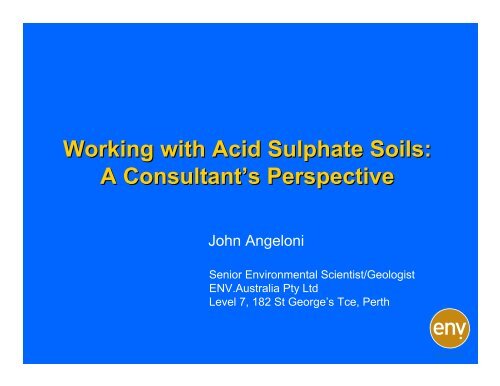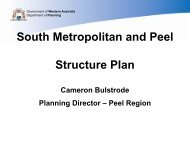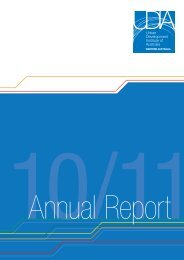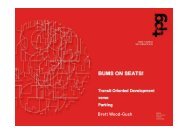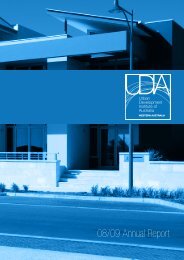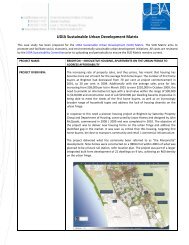Working with Acid Sulphate Soils: A Consultant's Perspective
Working with Acid Sulphate Soils: A Consultant's Perspective
Working with Acid Sulphate Soils: A Consultant's Perspective
Create successful ePaper yourself
Turn your PDF publications into a flip-book with our unique Google optimized e-Paper software.
<strong>Working</strong> <strong>with</strong> <strong>Acid</strong> <strong>Sulphate</strong> <strong>Soils</strong>:<br />
A Consultant’s s <strong>Perspective</strong><br />
John Angeloni<br />
Senior Environmental Scientist/Geologist<br />
ENV.Australia Pty Ltd<br />
Level 7, 182 St George’s Tce, Perth
Presentation Outline<br />
• ASS – Definition<br />
• Why consider ASS<br />
• ASS Investigations<br />
• ASS Management<br />
• Closure and the CS Act 2003
ASS Defined<br />
• <strong>Soils</strong>, materials and sediments<br />
that contain iron sulphides<br />
which, when drained or<br />
disturbed, react <strong>with</strong> oxygen to<br />
form sulphuric acid<br />
• The main form of iron sulphide<br />
present is pyrite (FeS 2 )<br />
• The pyrite is usually framboidal<br />
<strong>with</strong> extremely small crystal<br />
size and huge surface area –<br />
hence highly reactive
Actual <strong>Acid</strong> Sulfate <strong>Soils</strong><br />
•AASS – (after exposure to<br />
oxygen)<br />
pH
Potential <strong>Acid</strong> Sulfate <strong>Soils</strong><br />
•PASS – (before exposure to oxygen)<br />
pH 6.5-7.5, unoxidised iron sulfides,<br />
still have potential to produce acid,<br />
usually soft, sticky, gel-like mud (80%<br />
water) but can include wet sands
Why are ASS of Concern<br />
• If left alone, acid sulphate soils do not present a problem<br />
• However when exposed (eg drainage or excavation) iron sulphide<br />
react <strong>with</strong> oxygen and water to produce:-<br />
• sulfuric acid<br />
• iron, aluminium, arsenic, other metals and acid transported to<br />
surrounding environment<br />
Actual <strong>Acid</strong> <strong>Sulphate</strong> <strong>Soils</strong><br />
(AASS)<br />
Watertable<br />
Potential <strong>Acid</strong> <strong>Sulphate</strong> <strong>Soils</strong><br />
(PASS)
Over Regulation OR Serious Issue<br />
• Unprecedented level of development on the Swan<br />
Coastal Plain<br />
• Potential effects of climate change<br />
• Resilience of the land and groundwater to impact<br />
• Outcomes for future generations
ASS – the Costs<br />
• East Trinity - Queensland Government has committed >$10m over an 8 year<br />
period, predominantly for ASS-remediation and associated repair/replacement<br />
of corroded infrastructure<br />
• City of Stirling - approx. $20m<br />
• Raffles Hotel Redevelopment :<br />
• Perth Foreshore Enhancement<br />
– Ozone Reserve Irrigation Scheme: $600K<br />
– Esplanade:<br />
• Perth Arena: >$500K<br />
• Bunbury Region: Coastal residential development, waterway/marina -<br />
• Dunsborough Lakes – approx. $500K, just on neutralisation of a single<br />
stockpile from previous lake<br />
development
City of Stirling Residential Development<br />
• Mid-December 2001: bore-irrigated<br />
residential vegetable gardens dying in<br />
Stirling<br />
• <strong>Acid</strong>ic and metals–contaminated<br />
groundwater confirmed – Arsenic at up to<br />
1000 x WHO drinking water limit<br />
Groundwater acidity and As contamination<br />
related to residential developments<br />
(dewatering and disturbance of peat-based<br />
wetlands ), succession of dry seasons and<br />
Peat suggested as the major source of<br />
acidity, subsequently confirmed as source<br />
of Arsenic, other metals
WA Planning Guidelines<br />
Example Condition:<br />
from January 1 2004, based on ASS Risk Mapping in<br />
coastal areas<br />
‣Onus on developer<br />
To prove the absence of ASS, and if ASS present to<br />
develop management plan Prior to planning approval
ASS Risk Mapping - Perth
ASS Risk Mapping - Busselton
Aerial Photo of Site
ASS Investigations<br />
Photo: ENV 2007<br />
• Desktop Study: Aerial photography, ASS<br />
Risk Mapping, soil, geology, hydrogeology<br />
datasets<br />
• Test pits / drill holes/groundwater bores<br />
• Log and field test soil profile<br />
• Sample/analyse soils and groundwater<br />
• Prepare ASS Investigation Report and ASS<br />
and Dewatering Management Plan<br />
(ASSDMP)<br />
Photo: ENV 2007 Photo: ENV 2007
ASS Investigations<br />
TIMING<br />
Fieldwork (generally <strong>with</strong>in 4 weeks/20 days)<br />
Laboratory analysis (generally <strong>with</strong>in 3-4 weeks/say 20 days)<br />
DEC approval of ASSDMP (nominal 45 days)<br />
DoW issue of dewatering licence (nominal 10 days)<br />
Photo: ENV 2007<br />
Photo: ENV 2007
ASS Investigations-Results<br />
• Existing or Actual <strong>Acid</strong> <strong>Sulphate</strong> <strong>Soils</strong><br />
(AASS)<br />
• Potential <strong>Acid</strong> <strong>Sulphate</strong> <strong>Soils</strong> (PASS)<br />
• Presence, extent and severity<br />
• Is an ASSMP required
ASS Investigations - Cross Sections
ASS Investigations - Cross Sections
Management Options<br />
1. Avoid Disturbance<br />
2. Neutralisation Treatment<br />
3. Dewatering Management<br />
4. Strategic Re-burial<br />
Photo: ENV 2007<br />
Photo: ENV 2007<br />
Photo: ENV 2007
Dewatering<br />
HIGH RISK - critical component<br />
‣ oxidation of potential ASS materials surrounding<br />
the excavation associated <strong>with</strong> watertable<br />
drawdown<br />
‣ discharge/recharge of acidic groundwater<br />
‣ discharge/recharge of groundwater <strong>with</strong> elevated<br />
metal concentrations; TOTAL ACIDITY vs pH<br />
‣ retention ponds for aeration, lime treatment , silt<br />
curtains and monitoring
ASS and Dewatering Management<br />
Aeration<br />
Photo: , GHD 2003<br />
Photo: ENV 2007<br />
Photo: ENV 2007<br />
Photo: ENV 2007<br />
Retention/infiltration<br />
Basins<br />
Photo: ENV 2007<br />
Photo: ENV 2007<br />
Lime treatment<br />
Photo: ENV 2007
ASS AND DEWATERING<br />
MANAGEMENT<br />
Inline LIME DOSING PLANT: Automatic lime<br />
neutralisation determined by pH/EC of influent<br />
dewatering discharge
ASS AND DEWATERING<br />
MANAGEMENT<br />
• Infiltration - Iron- and metal-rich deposits
Closure Reporting<br />
• Initial Closure Report: Basis for DEC clearance of WAPC<br />
Condition<br />
“…management in accordance <strong>with</strong> approved ASS<br />
management plan…”<br />
• Post-Dewatering Closure Report – determines<br />
Contaminated Sites classification
Contaminated Sites Act 2003<br />
• Report of contamination – not substantiated.<br />
• Possibly contaminated – investigation required.<br />
• Not contaminated – unrestricted use.<br />
• Contaminated – restricted use.<br />
• Contaminated – remediation required.<br />
• Remediated for restricted use.<br />
• Decontaminated.
Aerial Photo of Site
Further Groundwater Investigation
Interpretation of potential human<br />
health impact<br />
• Small no. of lots classified as “CS – Restricted Use”<br />
subject to Health Risk Assessment
Consultants <strong>Perspective</strong><br />
• Timing – Investigations, lab analysis, DEC review<br />
• Too much (pre)caution: Inherent neutralising<br />
capacity of some naturally high lime soils; natural<br />
acidity of some soil/groundwater settings and risk of<br />
over-liming<br />
• CS Act 2003: overarching legislation, <strong>with</strong> a broad<br />
definition of contamination<br />
– Desirable to be able to restrict use of groundwater<br />
in some areas <strong>with</strong>out labelling them a<br />
contaminated site.<br />
– Uncertainties in DEC groundwater criteria for<br />
classification under CS Act (eg Health impact of<br />
pH and total acidity; metals [new guidelines<br />
pending]
Consultants <strong>Perspective</strong> (ctd(<br />
ctd)<br />
– reliance on consultants to fix some knowledge gaps<br />
– Worst case classification - remediation of an entire<br />
wetland, extensive groundwater remediation<br />
• Classification under CS act is based on post-work<br />
monitoring programme, and may therefore be unknown<br />
for a long time after the works have been conducted –<br />
uncertainty and impact on lot prices
Consultants <strong>Perspective</strong> (ctd(<br />
ctd)<br />
• Costs associated <strong>with</strong><br />
– repairing damaged infrastructure,<br />
– remediating disturbed ecosystems<br />
– treating contaminated groundwater aquifers<br />
• are much greater than any costs incurred in<br />
preventing or minimising impacts before they occur


